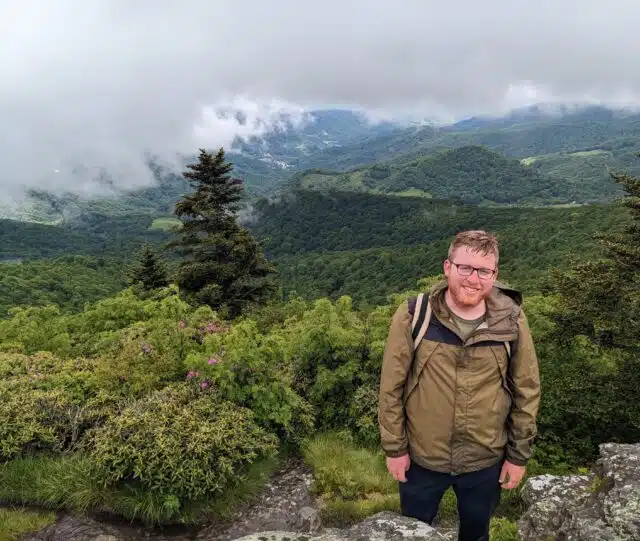
By Connor Ryan, Rhododendron Collections Manager
Lots of plants have problems in landscapes. Perhaps your Colorado spruce (Picea pungens) is losing all its lower leaves. Or your rhododendron’s stems keep dying. Or the leaves of your blueberry bush (Vaccinium) are completely yellow. How do you figure out what is causing the problem, and what is the solution? A common move for gardeners is to run to the local garden center, purchase fertilizer or a fungicide or an insecticide, and then use those products non-discriminately, praying that this will fix everything. While this can sometimes work, there are resources for the average gardener to help address garden problems more effectively and sustainably.
First and foremost, make sure you are planting your plant in the correct site. Planting the right plant in the right place is a critical step in ensuring landscape success. Does your plant perform well in wet areas? If not, don’t plant it there! Does it need acidic soils but your soil pH is 7.5? Don’t plant it in your yard! Does your plant need shade? Then plant it in shade!
The next most important thing to do is make sure you are planting your plant correctly. Nursery-grown plants are often planted too deep in their pots, so check to make sure there is a flare at the base of the trunk where it touches the soil. Nursery-grown plants can also be pot bound, making it hard for them to establish in the native soil. Do not purchase pot bound plants, and always loosen roots prior to planting. When planting, some researchers suggest going as far as to remove all the nursery potting mix from your plants’ root system to thoroughly inspect it and make corrections before planting, more details here.
If you’ve followed these steps and you are still having trouble, or you inherited a garden from someone else, there are resources to help gardeners gather data to diagnose their plant problems.
Many state universities have soil testing labs, such as Michigan State University and Pennsylvania State University. If you notice some kind of foliar abnormality, e.g. atypical coloration, consider sending off a sample. The lab will tell you what’s in your soil and make management recommendations. If you have too much phosphorous in your soil, stop putting down fertilizers with phosphorus! If your soil pH is high, plant plants that can tolerate higher pH. If the plant is really important to you, use elemental sulfur to lower pH.
Don’t know if your soils drain well? Dig a hole! A common way to assess soil drainage is a percolation test. In a percolation test (or perc. test), you dig a hole, fill it with water, and allow water to drain. Then you fill it again and time how long it takes to drain. If it drains slowly, plant plants that can tolerate wet feet! If it drains quickly, your plants may need irrigation when it is dry. For more details, see this write-up from the University of Kentucky Extension.
Does your plant get a leaf spot, have cankers on its stems, or have some unknown insect infestation? Collect a sample and send it off to a diagnostic laboratory, also at a state university, such as the Ohio State Plant and Pest Diagnostic Clinic.
If you need further assistance, consider reaching out to an extension office. Ohio State University and Central State University have extension offices located throughout the state to aid everyone, from average gardeners to large-scale farms. I also love the Garden Professors Facebook group, which is a no-nonsense group focused on science-based gardening.
We are currently undergoing this process for our rhododendron gardens, with help from a grant from the American Rhododendron Society. Many of our rhododendrons struggle, especially in our Rhododendron Discovery Garden. Rhododendrons have symptoms of root rot disease, lacebugs are abundant, foliage is yellow, overall growth is poor – the list goes on. We have hunches about what is causing these symptoms, but acting on hunches can be a huge waste of time. By collecting data, we can make evidence-based decisions about plant care and garden management.


Connor Ryan, MS
Rhododendron Collections Manager
My group is engaged in three things at Holden: curating the Rhododendron collection, breeding landscape plants, and stewarding the David G. Leach Research Station. Current collections focuses include North American native rhododendrons and azaleas, especially R. flammeum, R. prunifolium, and the Ohio natives, as well as any non-native species that may be adapted to our climate. Breeding focuses are on broader adaptability in elepidote rhododendrons, reblooming in evergreen azaleas, and a few smaller projects with Pieris and Hamamelis. We strongly believe in the value of living collections and are happy to share non-proprietary germplasm or accommodate collections-based scholarship. If you work for a botanical garden or nursery interested in rhododendrons (or azaleas) or are a scholar studying them, please get in touch. We would love to help with your work.












